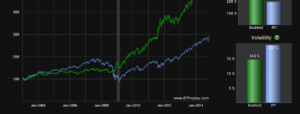There was a good piece in the WSJ today discussing potential “flaws” in Exchange Traded Funds (ETFs). ETFs are a relatively new product that have amassed huge quantities of assets in the last few decades but are still dwarfed by the mutual fund space (roughly 2.1 trillion in assets vs 12.6 trillion in mutual funds). The SEC recently said “It may be time to re-examine the entire ETF ecosystem.” That sounds a bit hyperbolic to me. ETFs aren’t necessarily dangerous unless you misunderstand them or misuse them. Unfortunately, a lot of behavioral bias appears to be driving the misguided fears about ETFs.
1. ETFs can be dangerous when misused. The first ETF founded in 1993 was the SPDR SPY which was designed to track the S&P 500. It’s a remarkably tax and fee efficient product that has served its investors very well since its founding. This was a very simple product designed for passive indexing, but the ETF space has morphed substantially since 1993. Much like the mutual fund space, it has morphed from a simple indexing product into a series of products that feed investor impatience and desire for rapid profits. And so we’ve seen a substantial surge in “active” ETFs, leveraged ETFs, “hedged” ETFs and other similar products. Many of these products abuse the efficiencies of ETFs by being tax inefficient and fee inefficient. They sell the diversification of indexing, but saddle investors with all the negatives that result in higher fees, tax inefficiencies and poor performance.
I’ve written substantially on the dangers of leveraged ETFs and how fund companies sell high fee closet indexing ETFs in exchange for empty promises about hedging and “market beating” returns. These products, in my opinion, are often dangerous and sold on false premises. But that does not mean we should make sweeping generalizations about the entire ETF space. The fact that some ETFs are bad does not mean they are all bad.













Leave A Comment